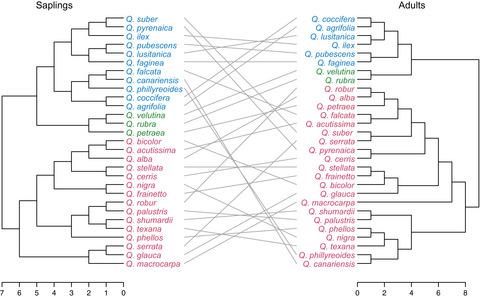Our official English website, www.x-mol.net, welcomes your
feedback! (Note: you will need to create a separate account there.)
Ontogenetic consistency in oak defence syndromes
Journal of Ecology ( IF 5.3 ) Pub Date : 2020-02-27 , DOI: 10.1111/1365-2745.13376 Xoaquín Moreira 1 , Luis Abdala‐Roberts 2 , Andrea Galmán 1 , Andrew W. Bartlow 3 , Jorge C. Berny‐Mier y Teran 4 , Elisa Carrari 5 , Felisa Covelo 6 , María de la Fuente 1 , Scott Ferrenberg 7 , Nikolaos M. Fyllas 8 , Yasutomo Hoshika 5 , Steven R. Lee 7 , Robert J. Marquis 9 , Masahiro Nakamura 10 , Colleen S. Nell 11 , Mario B. Pesendorfer 12 , Michael A. Steele 13 , Carla Vázquez‐González 1 , Shuang Zhang 14 , Sergio Rasmann 15
中文翻译:

橡树防御综合症的个体发育一致性
更新日期:2020-02-27
Journal of Ecology ( IF 5.3 ) Pub Date : 2020-02-27 , DOI: 10.1111/1365-2745.13376 Xoaquín Moreira 1 , Luis Abdala‐Roberts 2 , Andrea Galmán 1 , Andrew W. Bartlow 3 , Jorge C. Berny‐Mier y Teran 4 , Elisa Carrari 5 , Felisa Covelo 6 , María de la Fuente 1 , Scott Ferrenberg 7 , Nikolaos M. Fyllas 8 , Yasutomo Hoshika 5 , Steven R. Lee 7 , Robert J. Marquis 9 , Masahiro Nakamura 10 , Colleen S. Nell 11 , Mario B. Pesendorfer 12 , Michael A. Steele 13 , Carla Vázquez‐González 1 , Shuang Zhang 14 , Sergio Rasmann 15
Affiliation

|
- Plant species allocate resources to multiple defensive traits simultaneously, often leading to so‐called defence syndromes (i.e. suites of traits that are co-expressed across several species). While reports of ontogenetic variation in plant defences are commonplace, no study to date has tested for ontogenetic shifts in defence syndromes, and we know little about the ecological and evolutionary drivers of variation in plant defence syndromes across ontogeny.
- We tested for ontogenetic variation in plant defence syndromes by measuring a suite of defensive and nutritional traits on saplings and adult trees of 29 oak (Quercus, Fagaceae) species distributed across Europe, North America, and Asia. In addition, we investigated if these syndromes exhibited a phylogenetic signal to elucidate the nature of their macro‐evolutionary variation, whether they were associated with levels of herbivore pressure and climatic conditions, and if any such evolutionary and ecological patterns were contingent on ontogeny.
- Our analyses revealed three distinct oak defence syndromes: the first included species with high defences, the second species with high defences and low nutrient levels, and the third species with high nutrients and thinner leaves. Interestingly, these defence syndromes remained virtually unchanged across the two ontogenetic stages sampled. In addition, our analyses indicated no evidence for a phylogenetic signal in oak syndromes, a result consistent across ontogenetic stages. Finally, with respect to ecological factors, we found no effect of climatic conditions on defences for either ontogenetic stage, whereas defence syndromes were associated with differing levels of herbivory in adults but not saplings suggesting an association between herbivore pressure and syndrome type that is contingent on ontogeny.
- Synthesis. Together, these findings indicate that defence syndromes remain remarkably consistent across oak ontogenetic stages, are evolutionarily labile, and while they appear unrelated to climate, they do appear to be associated with herbivory levels in an ontogenetic‐dependent manner. Overall, this study builds towards a better understanding of ecological and evolutionary factors underlying multivariate plant defensive phenotypes.
中文翻译:

橡树防御综合症的个体发育一致性
- 植物物种同时将资源分配给多个防御性状,通常会导致所谓的防御综合症(即在几种物种中共表达的一系列性状)。虽然关于植物防御的个体遗传变异的报道很普遍,但迄今为止,尚无任何研究测试防御综合症的遗传变异,而且我们对整个个体防御变异的生态和进化驱动力知之甚少。
- 我们通过测量分布在欧洲,北美和亚洲的29种橡树(栎属,菊科)的树苗和成年树上的防御性和营养性状来测试植物防御综合症的个体发育变异。此外,我们调查了这些综合症是否表现出系统发育信号,以阐明其宏观进化变异的本质,是否与草食动物压力水平和气候条件有关,以及是否有这种进化和生态模式取决于个体发育。
- 我们的分析揭示了三种不同的橡树防御综合症:第一种包括高防御力的物种,第二种具有高防御力和低养分水平的物种,第三种具有高养分且叶片较薄的物种。有趣的是,这些防御综合症在抽样的两个个体发育阶段中几乎保持不变。另外,我们的分析表明没有证据表明橡树综合症中存在系统发育信号,这一结果在个体发育阶段是一致的。最后,关于生态因素,我们没有发现气候条件对任何个体发育阶段的防御都没有影响,而防御综合症与成年草食动物的不同水平相关,而幼树则没有,表明草食动物压力与综合症类型之间的关联取决于个体发育。
- 合成。总之,这些发现表明,防御综合症在橡树的各个发育阶段之间保持着显着的一致性,在进化上不稳定,尽管它们看起来与气候无关,但它们确实以与个体发育相关的方式与食草水平相关。总体而言,本研究旨在更好地理解多元植物防御表型的生态和进化因素。










































 京公网安备 11010802027423号
京公网安备 11010802027423号